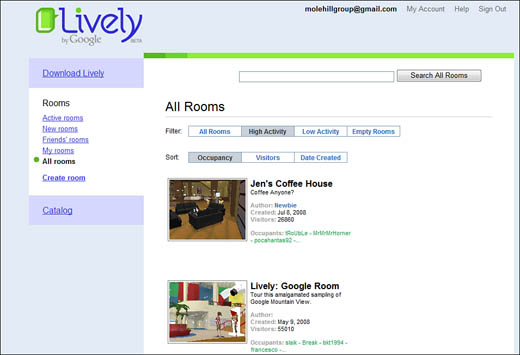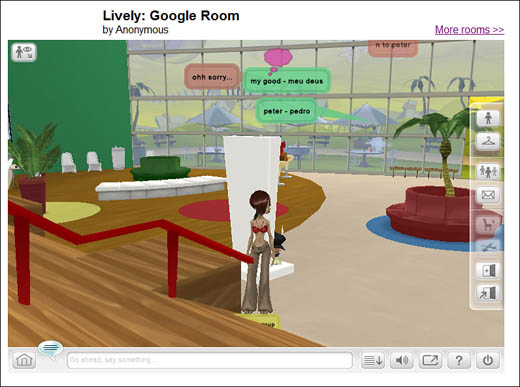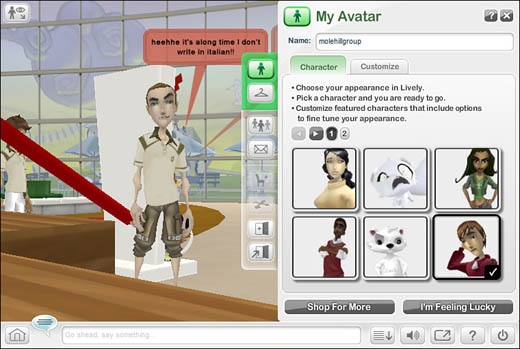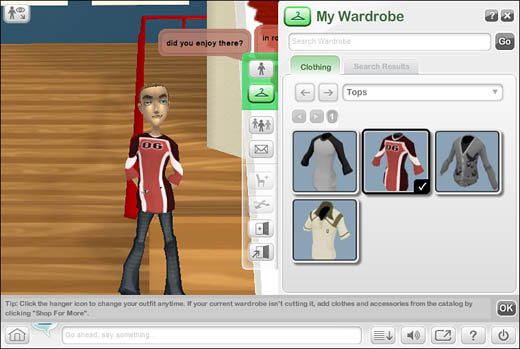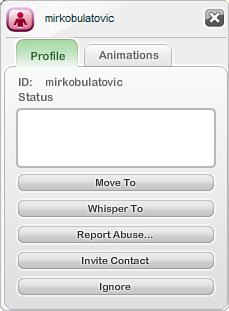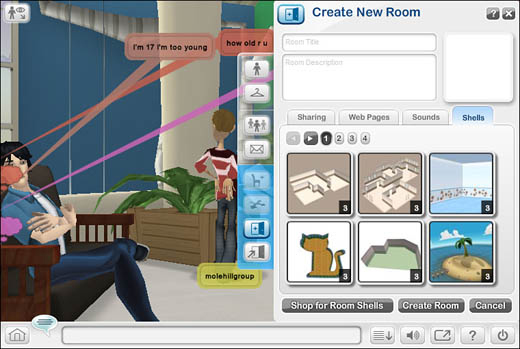Google describes Lively as a three-dimensional chat world. As such, it doesn’t have quite the functionality as a true virtual world, such as Second Life. It’s more like a traditional chat room where each chatter has his or her own 3D character onscreen.
Note
There’s a lot more to Lively than what we can cover in this chapter. For example, you can embed virtual rooms in your own website and create your own furniture and other items. If this interests you, spend some time on the Lively site, and get to know what’s available.
Like Second Life, the Lively characters (called avatars) can be personalized to suit your personality, and they move around onscreen in a three-dimensional virtual space. The Lively site has numerous virtual chat rooms; you can choose to chat in an existing room or create your own new room. Up to 20 people can occupy a room at one time.
Lively doesn’t require any special software to run; instead, it runs within your web browser (Internet Explorer or Mozilla Firefox). It’s flash-based, and you have to download a small browser plug-in before you can start chatting. As of fall 2008, Lively runs on Windows XP and Windows Vista, but not on the Mac.
You download the Lively client from the Lively home page (www.lively.com). When you first access Lively, you’re asked to choose an ID. After you’re logged in, you choose which virtual rooms you want to visit. Figure 17.1 shows the list of available rooms; you can view new rooms, friends’ rooms, your favorite rooms (my rooms), or all rooms. You can even search for rooms by name or topic.
When you enter a room, you see a 3D space like the one shown in Figure 17.2. Other users appear as human-like avatars; their comments appear as speech balloons over their avatars.
You look around a room by using the mouse like a joystick. Simply click and drag to move your viewpoint back and forth and side to side. To move your avatar, click your character with the mouse to display the four-arrow cursor, and then click and drag your avatar throughout the room.
To choose or change your avatar, click the My Avatar button on the room’s control bar on the right. This opens the My Avatar pane, shown in Figure 17.3. Start by choosing a predesigned character from the Character tab, and then click the Customize tab to personalize your avatar with different hair, skin color, and the like.
To change your avatar’s clothing, click the My Wardrobe button. The My Wardrobe pane, shown in Figure 17.4, lets you choose from a variety of clothing styles.
Chatting in a Lively room is just like chatting in any other online chat room or instant-messaging program. To talk, enter your text into the chat box at the bottom of the screen, and press Enter. This puts your message onscreen in a speech balloon. This is also how you “listen” to other users—by reading their speech balloons.
To make your avatar perform a specific motion, click your avatar to display your profile, and then select the Animations tab. You can choose from a variety of motions, from angry to “yes,” with several dances and rude gestures in between.
You can also view everyone’s messages in a text-based chat window. Click the People button in the room’s control bar, and then select the Chat tab. As you can see in Figure 17.5, this displays a more traditional text version of everyone’s conversations.
Note
Sometimes your avatar performs an action based on the text you type. For example, if you type “hi,” your avatar waves.
Just remember that when you talk in this fashion, you’re talking to everyone in the room, not just to another individual. To have a private conversation with another user—what Lively calls a “whisper”—click that person’s avatar to display the profile box, shown in Figure 17.6. This displays the person’s profile and lets you initiate a private conversation. Just click the Whisper To button, and you see the dialog box shown in Figure 17.7. Enter your private message, and then click the Send button.
Most Lively users are content chatting in the numerous preexisting virtual rooms. But if the mood strikes, you can create your own rooms, for your own public or private purposes.
From within an existing room, click the New Room button in the control bar. This opens the Room Properties pane; click the Create New Room button.
You now see the Create New Room pane, shown in Figure 17.8. Here you give your room a title and description, as well as choose a “shell” for your room. (A shell is merely the starting layout for how the room will eventually look.) You can also click the Sounds tab to add background music to your room.
Now click the Sharing tab. If you want your room to be available to the public, check the Include This Room in the Lively Room List Where Anyone Can Find It option. You can also determine whether you want visitors to be able to “decorate” the room. Click the Create Room button, and your room is created.
To decorate your new room, click the Furniture & Things button. When the Furniture & Things pane appears, pick out the items you want. Then, when you’re done adding furniture and things, click the Move Furniture button; this lets you place your new items within your room.

